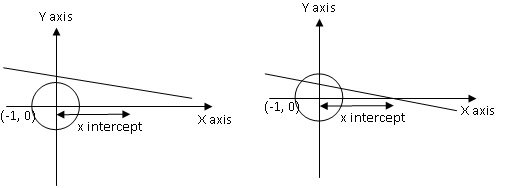
We will discuss how to use diagrams to solve DS questions today. The thought process used for a DS question is different from the thought process used for a PS question. To find whether a statement is sufficient to answer the question, you should try to prove that it is not sufficient. Try to make two cases which answer the question differently using the give information. If there are two or more different answers possible, it means the given information is not enough. Let’s discuss this with the help of an official question.
Question: A circle and a line lie in the ![]() plane. The circle is centered at the origin and has a radius 1. Does the line intersect the circle?
plane. The circle is centered at the origin and has a radius 1. Does the line intersect the circle?
Statement I: The ![]() -Intercept of the line is greater than 2
-Intercept of the line is greater than 2
Statement II: The slope of the line is ![]()
Solution:
We are given that there is a circle and a line on the ![]() plane. The line can lie anywhere – it may or may not intersect the circle. The circle has radius 1 so it intersects the
plane. The line can lie anywhere – it may or may not intersect the circle. The circle has radius 1 so it intersects the ![]() axis at (1, 0) and (-1, 0).
axis at (1, 0) and (-1, 0).
Let’s look at the information given in the two statements:
Statement I: The ![]() -Intercept of the line is greater than 2.
-Intercept of the line is greater than 2.
If ![]() intercept > 2, the line can be any of the following (and can be drawn in many more ways)
intercept > 2, the line can be any of the following (and can be drawn in many more ways)

We found two cases – one in which the line intersects the circle and another in which it doesn’t. The line could have different slopes and different ![]() intercepts (as long as it is greater than 2) to get different cases. Hence we see that this information alone is not sufficient to answer the question.
intercepts (as long as it is greater than 2) to get different cases. Hence we see that this information alone is not sufficient to answer the question.
Statement II: The slope of the line is ![]() .
.
If slope of the line is ![]() , the line can be drawn in any of the following ways (and many more).
, the line can be drawn in any of the following ways (and many more).

Again, we found two cases – one in which the line intersects the circle and another in which it doesn’t. The slope of the line stays the same but you can move it up or down to get the two different cases (and different ![]() intercepts). Hence, we see that this information alone is not sufficient to answer the question.
intercepts). Hence, we see that this information alone is not sufficient to answer the question.
Using both together: Now the line has a defined slope ![]() but it has no defined
but it has no defined ![]() intercept. To get
intercept. To get ![]() intercept greater than 2, all we need is that
intercept greater than 2, all we need is that ![]() intercept must be greater than
intercept must be greater than ![]() . If you are wondering how we arrived at this, recall:
. If you are wondering how we arrived at this, recall:
![]()
![]()
Since ![]() intercept must be greater than 2,
intercept must be greater than 2, ![]() intercept will be greater than
intercept will be greater than ![]() .
.
If the ![]() intercept is much more than
intercept is much more than ![]() , it will not intersect the circle. If the
, it will not intersect the circle. If the ![]() intercept is a little more than
intercept is a little more than ![]() , the line will intersect the circle (as shown by the two diagrams in Fig 2). In one case, it will intersect the circle, in the other case, it will not. So both statements together are not sufficient.
, the line will intersect the circle (as shown by the two diagrams in Fig 2). In one case, it will intersect the circle, in the other case, it will not. So both statements together are not sufficient.
Answer (E).